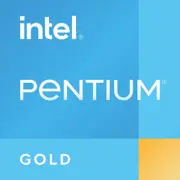Intel Pentium Gold G6500T

Intel Pentium Gold G6500T: A Budget Processor for Basic Tasks in 2025
Updated: April 2025
Introduction
In an era of multi-core processors and neural networks, even budget chips remain in demand. The Intel Pentium Gold G6500T, released in 2020, is still available for purchase thanks to its low cost (around $50–60) and energy efficiency. Let's explore who this CPU is suitable for in 2025 and what compromises may need to be made.
1. Key Specifications
Architecture and Process Technology
The processor is built on the Comet Lake architecture (10th generation Intel Core) with a 14 nm manufacturing process. This is an outdated technology, but it is sufficient for simple tasks.
- Cores and Threads: 2 cores, 4 threads (Hyper-Threading).
- Base Frequency: 3.5 GHz; no turbo boost.
- Cache: 4 MB L3.
- TDP: 35 W — ideal for compact systems.
Key Features:
- Intel UHD Graphics 630 — integrated graphics supporting 4K@60 Hz (HDMI/DisplayPort).
- Intel Quick Sync Video support — accelerates video encoding.
- Energy Efficiency — suitable for passive cooling.
2. Compatible Motherboards
Socket and Chipsets
- Socket: LGA 1200.
- Chipsets: H410, B460, H470, Z490 (for Comet Lake).
Selection Recommendations:
- Budget Option: H410 ($50–70) — suitable for office PCs.
- Best Choice: B460 ($70–90) — supports USB 3.2 Gen 2, more SATA ports.
- Important: Avoid 500-series chipsets (e.g., B560) as they are incompatible with Comet Lake.
Practical Example: The ASRock B460M-HDV board at $80 provides stable operation with DDR4-2666 and has 4 memory slots.
3. Supported Memory Types
- Type: DDR4 (DDR5 and LPDDR4 are not supported).
- Maximum Frequency: 2666 MHz (limited by H410/B460 chipsets).
- Modes: Dual-channel (installation of two modules is recommended).
Recommended Amount:
- Basic Tasks: 8 GB (2x4 GB).
- Multimedia: 16 GB (2x8 GB) — for browsing and streaming video.
Tip: Choose memory with low timings (CL16) for a small performance boost.
4. Recommended Power Supplies
- Power: Even with a discrete graphics card (e.g., GTX 1650), a 400 W PSU will suffice.
- For systems without a graphics card: 250–300 W is sufficient.
Examples:
- Budget Option: EVGA 400 W1 ($35) — 80+ White certification.
- Reliable Choice: Corsair CX450 ($55) — 80+ Bronze, semi-modular design.
Important: Don’t skimp on the PSU — cheap models can damage components.
5. Pros and Cons
Pros:
- Price: One of the most affordable processors in 2025.
- Energy Efficiency: Suitable for mini-PCs and passive cooling systems.
- Integrated Graphics: UHD 630 handles 4K video and light gaming (e.g., Minecraft on low settings).
Cons:
- 2 Cores: Multitasking is limited — running a browser with 20 tabs and background tasks may cause lag.
- Outdated Architecture: Lags behind modern AMD APUs in performance per watt.
- No PCIe 4.0 support — relevant only for high-speed NVMe drives.
6. Use Scenarios
Office Tasks
- Document work, video conferencing, email.
- Example: A system based on G6500T, 8 GB DDR4, and a 256 GB SSD — ideal for remote work.
Multimedia
- Watching 4K video, streaming (Netflix, YouTube).
- Limitation: No hardware support for AV1 — streaming services in 2025 may require hardware upgrades.
Light Gaming
- Intel UHD 630: CS:GO at 720p (30–40 FPS), Dota 2 on low settings.
- Tip: Add a GTX 1650 ($120) graphics card for Full HD gaming.
Home Server
- Low power consumption allows the CPU to be used in a NAS or media center (e.g., with Plex software).
7. Comparison with Competitors
AMD Athlon 3000G ($45)
- Pros: Vega 3 graphics are more powerful, unlocked multiplier.
- Cons: No Hyper-Threading, outdated AM4 socket.
Intel Celeron G6900 ($55)
- Pros: Alder Lake architecture (10 nm), 2 cores/2 threads.
- Cons: Weaker in multi-threaded tasks.
Conclusion: G6500T excels due to Hyper-Threading but falls short in graphics compared to Athlon.
8. Practical Assembly Tips
- Case: Choose compact models (e.g., Fractal Design Core 500) to save space.
- Cooling: The stock cooler is sufficient, but a Noctua NH-L9i ($45) is suitable for quiet operation.
- Storage: Always use an SSD (e.g., Kingston A400 480 GB for $30).
- Networking Options: Add a Wi-Fi adapter (e.g., TP-Link Archer TX50E for $40) if the motherboard lacks wireless capability.
9. Final Verdict: Who is the Pentium Gold G6500T Suitable For?
This processor is an option for those who:
1. Are building a budget PC for office work, studies, or web surfing.
2. Need an energy-efficient system (e.g., home server).
3. Plan to use the PC as a media center capable of 4K video output.
Why should you avoid the G6500T in 2025?
- For gaming and video editing, it’s better to choose an AMD Ryzen 3 5300G ($90) or Intel Core i3-12100 ($110).
- If you need a modern platform with DDR5 and PCIe 5.0 support, consider Alder Lake or Ryzen 7000 processors.
Conclusion
The Intel Pentium Gold G6500T is an example of a “workhorse” for undemanding tasks. Priced at $50–60, it remains relevant in 2025, but should only be considered under a strict budget. For future upgrades, opting for a more modern platform is advisable.
Basic
CPU Specifications
Memory Specifications
GPU Specifications
Miscellaneous
Benchmarks
Compared to Other CPU
Share in social media
Or Link To Us
<a href="https://cputronic.com/en/cpu/intel-pentium-gold-g6500t" target="_blank">Intel Pentium Gold G6500T</a>